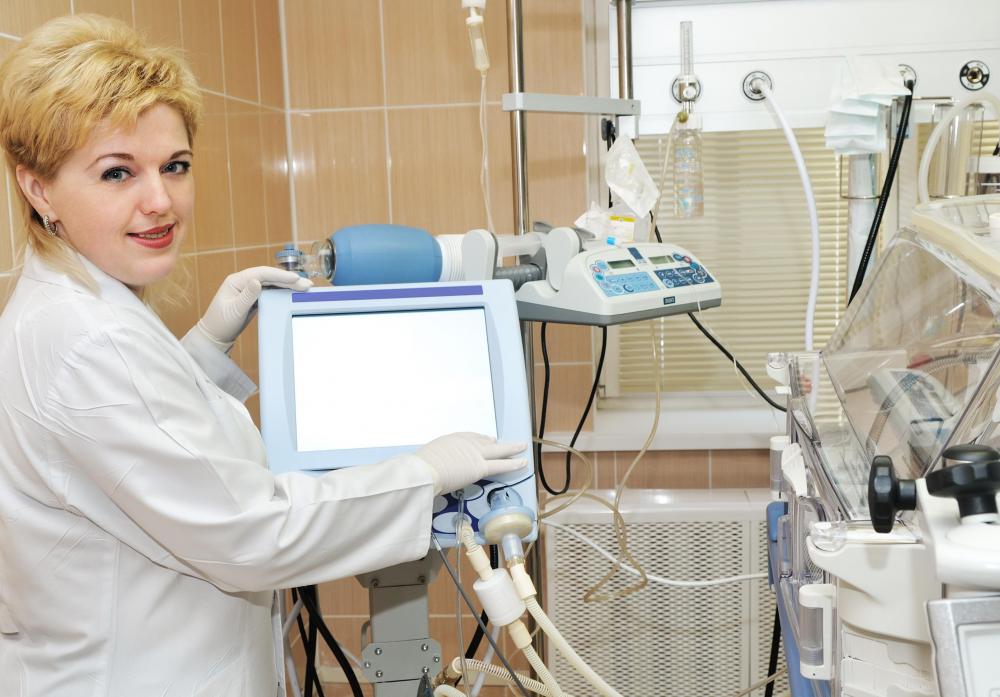At TheHealthBoard, we're committed to delivering accurate, trustworthy information. Our expert-authored content is rigorously fact-checked and sourced from credible authorities. Discover how we uphold the highest standards in providing you with reliable knowledge.
What is a SIMV Ventilator?
A synchronized intermittent mandatory ventilation device, also known as a SIMV ventilator, is a medical device that helps people breathe. In most cases it’s a portable machine with variable controls that is attached to a mask that a person wears over his or her nose or mouth. The machine detects how many breaths he or she is able to take independently, and then provides or “forces” the others that a doctor or other healthcare professional has deemed are necessary for optimal health. Ideally the ventilator will be used less and less frequently as a patient recovers, and the main idea is that it will one day be abandoned. Depending on the reasons it’s being used in the first place, though, this may not be possible. Synchronized ventilators are usually considered to be a good option for patients who are able to breath a little bit on their own, but some studies have shown that these sorts of devices can actually make entirely independent breathing harder, or at least take longer than it might with a different sort of ventilator system. People who are considering using this sort of device are usually wise to discuss all of the benefits and possible drawbacks with their healthcare provider.
How it Works

Many ventilator machines have multiple settings, and SIMV ventilator mode is used to support a patient who is taking some breaths alone. This is done by setting the vent to give a certain amount of pressure along with the spontaneous breath. Most models are able to detect how many breaths a patient is taking, and then synchronize and adjust as necessary.

Importantly, in addition to forcing needed breaths, it also prevents a person from taking too many breaths. Early ventilator models would sometimes not account for patient’s independent efforts, which could lead to breaths from the lungs and from the machine being stacked back to back and often left the patient in more distress because of air pressure building up in the lungs. Modern iterations of the device allow each breath the patient takes to be a full and adequate one.
People Who Benefit Most

This type of ventilation is usually considered “minimally invasive,” which basically means that it is one of the least intrusive options available. Any sort of mechanical ventilation is designed to make sure that a respiratory-compromised patient will inhale and exhale by supplying the oxygen needed to breath in, and providing for and regulating the exhalation of carbon dioxide. A SIMV device is used when a patient makes some spontaneous respiratory effort independently, such as when he or she has recovered sufficiently for medical professionals to consider removing ventilation at some point.

This type of ventilation is most often successful for those people who are somewhat awake, who are taking at least minimal breaths per minute independently, and who are preparing to be extubated and weaned from the ventilator entirely in the near future. SIMV is the most common form of ventilation and the least damaging to lung tissue, but it also requires the patient to do most of the work. It is tolerated the best in most instances, but it does increase the patient's breathing workload and can increase respiratory muscle fatigue. It isn’t usually a good choice for people who need extensive help breathing, or who aren’t expected to breath independently soon if at all.
Making the Choice
There are typically several different ventilation options, and healthcare providers consider the condition of the patient, the extent of the illness or injury, and the overall prognosis when making a choice. SIMV ventilator mode is the one most often used for children and babies whose lungs often develop and heal more quickly. Adults often tolerate it relatively well under most circumstances unless they’re heavily sedated or the injury to the lungs does not allow for spontaneous respirations.
In almost all cases the choice of ventilation is made by the attending medical professional based on clinical assessments and blood gas analysis. Patients may tire on SIMV and need another mode for a day or two before resuming it in the lead up to being weaned from ventilation entirely.
Drawbacks
No ventilation system is perfect, and simulated models — while they’re usually some of the least intrusive — also have some drawbacks. In most cases these are most pronounced for people who require help over a long period of time. Some studies have shown, for instance, that patients who have depended on simulated ventilation for a number of years often find it harder to actually breathe entirely on their own once they give up the device than they would have if they’d been on different type of system; over time, the simulated, spontaneous forced breaths can also cause the respiratory muscles to weaken in some patients. There are a lot of reasons why the simulated technology might be best, but figuring out whether the drawbacks outweigh the benefits is usually something that can only be decided in a direct conversation between a patient and a healthcare provider.
AS FEATURED ON:
AS FEATURED ON:














Discuss this Article
Post your comments